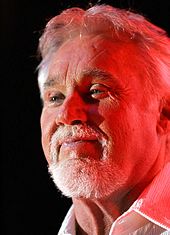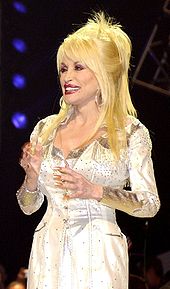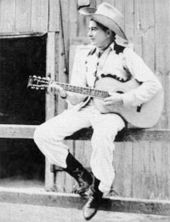Country music
![]()
Country is a redirect to this article. For other meanings, see Country (disambiguation).
Country music, also known as country [ˈkʌntri] for short, is a musical genre originating in the USA, which emerged at the beginning of the 20th century from traditional elements of the folk music of European immigrant peoples - especially from Ireland and England. Originally native to the southern Appalachians, old-time music developed into country music through urban influences and the adoption of elements of other musical genres - such as the blues.
The term Country & Western or C&W, which is often used as a synonym, is misleading because it suggests that this is a uniform genre. The term goes back to a chart designation under which the American Billboard magazine listed titles from the genres of country and western music together in the 1940s.
The history of country music is marked by three overlapping movements:
- The traditionalists advocate a return to the original lyrical and musical themes.
- The innovators experiment with new styles, forms of expression and instruments.
- The commercially oriented seek proximity to pop music in order to appeal to as large an audience as possible.
A typical characteristic of country music are direct lyrics, which often refer to American living conditions, describe personal experiences, comment on current events and are not infrequently humorous.
Traditional country music mainly uses string instruments such as guitar, banjo, mandolin, double bass or fiddle (a simple violin), but also accordion, piano or harmonica. In contemporary country, drums and electric guitar and bass are added, following the instrumentation of rock music.
Styles
Country music can be divided into styles, some of which have been current for many decades, while others have only regional, ethnic, or intermittent significance. The original country music before 1920 is called old-time or hillbilly music, while the music that dominated in the 1990s is called new country.
The main styles
Bluegrass
Bluegrass is mainly played with acoustic instruments in 2/4 time. Characteristic are the virtuosity of the musicians, the polyphonic sentence singing and the fast instrumental pieces. The typical instrumentation of this style consists of fiddle, banjo, mandolin, double bass and western guitar. The original home of bluegrass is the Appalachian Mountains in the southeastern United States, and Kentucky was long considered an important center. Thus, bluegrass is still often referred to as "mountain music" or "old-time music", although this term rather refers to the traditional folk music of the Appalachians, from which bluegrass emerged.
The common name goes back to the Blue Grass Boys, the band of Bill Monroe, who is considered the original founder of commercial bluegrass music. Other style-setting musicians of bluegrass in the founding years were banjo player Don Reno, The Stanley Brothers, Bobby and Sonny Osborne, Jim and Jesse McReynolds, and bands like Hylo Brown and The Timberliners. Bluegrass evolved into newgrass in the 1960s, which also adopted modern stylistic elements and caused a sensation with the group New Grass Revival during the 1980s. Representatives of today's bluegrass are for example Alison Krauss, Sam Bush, Tim O'Brien, Ricky Skaggs, Rhonda Vincent and Del McCoury. Bluegrass is still very popular in the USA and also commercially successful. Bluegrass motifs are omnipresent in modern country music, a typical example being the older works of the Dixie Chicks.
honky tonk
The honky tonk (colloquial for pub, bar) originated in the clubs and dance halls around the Texas oil fields. There it was so loud in many places that the instruments had to be amplified electrically and a drum kit was indispensable. Mostly simple and slow 2/4-beats are played, which get the typical groove by a special timing. The lyrics deal with everyday problems and are unaffected and direct. They have little in common with the folkloristic and homeland-connected content of traditional country music. Later, honky-tonk music became the epitome of Southern mood music, in which almost everything revolves around "beer, women and song".
As a style of neo-traditional country music, honky tonk is still of elementary importance and exemplary for country music in Texas and Oklahoma. It was influenced by Hank Williams Sr., Bob Wills and Merle Haggard, for example. Instrumentally it is characterized by fiddles, honky-tonk pianos and a wide range of guitars (electric basses, electric slide and pedal steel guitars, occasionally also dobros). The honky-tonk style is represented by almost all neo-traditionalists, for example David Ball, David Lee Murphy, Jeff Carson, Mark Chesnutt, Tracy Byrd or George Strait.
Nashville Sound
From the mid-1950s onwards, country music lost ground dramatically to rock 'n' roll. Influential producers - most notably Chet Atkins and Owen Bradley - then began to smooth out the unpolished music, making it accessible to a wider audience. The result was a softer sound, often enhanced by background choruses. Classic country instruments such as fiddle or pedal steel guitar were rarely used. While traditionalists still predominated in the 1950s and 1960s, country-pop took over in the mid-1970s, helping the Nashville sound to take off. Many traditionalists, such as George Jones and Loretta Lynn, adapted to the new environment. On the other hand, many artists later swayed to the neo-traditionalist boom, including Ricky Van Shelton, Steve Wariner, Dolly Parton and Kenny Rogers. The urban-cowboy wave was characterized by melodic country-pop in the Nashville sound, string backdrop and the use of synthesizers.
Western Swing
Western Swing was developed in the 1930s by Bob Wills and Milton Brown. It essentially consists of a combination of traditional Texan music with elements of the blues and various styles of jazz and was influenced by other styles in the course of its development. Its characteristic feature is the combination of actually rather urban bigbands or their typical sound and the more rural cowboy image. This resulted in a lively, danceable music that was especially popular in the big dance halls of Texas and Oklahoma. Western swing was one of the more important styles of country music, but has declined in importance since the late 1940s. Modern representatives of Western Swing include Asleep at the Wheel, Prairie Oyster or Hot Club Of Cowtown.
Americana
Americana is primarily the socially critical music of American singer-songwriters based on American folk motifs, some of whom have achieved commercial success. Unlike the traditional folk of British-Irish origin, which is more strongly rooted in the northwest of the USA, Americana shows strong influences of rock and southern music. Many artists in this scene include themselves among the country singers, and some have repeatedly released pure country albums. Among the latter are Emmylou Harris, Rodney Crowell, Mary Chapin Carpenter or Kelly Willis. Typical songwriters are Nanci Griffith, Rosi Flores, Shawn Mullins, Delbert McClinton or Joe Ely. Americana is also called alternative country or roots rock.
Regional styles and fashion trends
Bakersfield Sound
In the early 1960s, a variant of country music based on rockabilly and honky tonk emerged in Bakersfield, California, where electrically amplified instruments predominated for the first time. Compared to the mellow Nashville sound, the guitars sounded hard and trebly. The arrangements were simpler. The Bakersfield sound was shaped by performers such as Buck Owens and Merle Haggard, and from the mid-1980s by Dwight Yoakam.
Western Music
Cowboy or Western music is the name given to a style of music that romanticizes the conquest of the American West and the life of the cowboys. It had its peak during the 1930s and 1940s; well-known representatives were Roy Rogers, Gene Autry, Tex Ritter, Tex Fletcher and The Sons of the Pioneers. Typical of western music is the accordion, along with guitar and fiddle, and often polyphonic harmony singing. Cowboy music sings about the vastness of the landscape and everyday life on the prairie, especially the bond with the horses. The melodious, often languorous ballads rubbed off stylistically strongly on the Western Swing.
A specialty of cowboy music is "blue yodeling," an American variation of yodeling. Some of the most important contemporary performers are Michael Martin Murphey, Riders in the Sky or Sons of the San Joaquin. Western music has also influenced other styles throughout the ages: For example, the music of performers such as Jimmie Rodgers and later Marty Robbins was sometimes heavily inspired by cowboy music. The image of country music was essentially shaped by Western music: even representatives of the New Country generation, who have little to do with the subject matter, appear in cowboy outfits.
Neo-Traditionalism
Neo-traditionalism emerged in the mid-1980s as a response to country music's loss of identity due to pop influences. A small group of performers around George Strait, Randy Travis, Clint Black, Keith Whitley, John Anderson and Ricky Skaggs released albums of tradition-oriented music, sparking a trend that lasted until the late 1990s and dominated the charts for many years. In the 1990s, successful star performers such as Garth Brooks, Alan Jackson or Tracy Lawrence are typical representatives of the New Traditionalist Movement, who gave traditional country music a modern makeover and enriched it with rock and blues elements.
After a very female-driven pop current around the turn of the millennium, the neo-traditionalists are generally strongly represented in the charts again, for example with the Dixie Chicks, who have, however, turned more to rock-pop since 2006, Toby Keith, Josh Turner, Billy Currington, Trace Adkins, Dierks Bentley and Brooks & Dunn. The Neo-Traditionalists are strongly influenced by the music of the southern states like Texas Music, Honky-Tonk, Western Swing, Southern Rock but also Bluegrass.
Outlaw
Since the early 1960s, producers had been gaining more and more power in Nashville. The actual performers had hardly any influence on the musical design and song selection. Some stars, most notably Waylon Jennings, Willie Nelson, Johnny Cash and Kris Kristofferson - also known as The Highwaymen - then began to produce their records themselves. More and more musicians joined in, and the Outlaw movement dominated the scene.
Since the 1980s, edgy-rock titles, idiosyncratic lyrics and not infrequently rough voices have predominated. Typical representatives are Hank Williams, Jr, David Allan Coe, Steve Earle and Charlie Daniels. They are all considered the pioneers of modern country rock and are counted among the tradition-bound Southern rock scene, which is located in the forefront of country music close to the roots of rock music (roots rock, traditional blues and rock 'n' roll) and in which bands like Lynyrd Skynyrd or performers like John Fogerty play music.
Rockabilly
Rockabilly was the first all-white style of rock 'n' roll and emerged when young white musicians interpreted black rhythm & blues and mixed it with country elements. The boom of this music was limited to the American southern states and to the time between 1954 and 1957. Characteristics are sparse instrumentation with double bass played percussively, electric lead guitar and nervous "hiccup singing". A tape echo is often used, which gives rockabilly a "bubbling groove". Typical representatives of this style were, besides the early Elvis Presley, also Carl Perkins, Eddie Cochran and Gene Vincent.
Country Rock
Country rock combines the above-mentioned musical genres of outlaw and southern rock with rockabilly and traditional blues. From pure roots rock it differs only the musical preparation such as smooth sound, catchy rhythms and integration of typical country instruments such as fiddles and steel guitars next to various electric guitars. Rock was able to assert itself strongly in the modern line dance scene, which is in intimate exchange with the country mainstream; even the neo-traditional honky tonk was partly influenced by country rock. Well-known performers include Alabama, Linda Ronstadt and The Byrds.
The modern country music (New Country) of the charts is sometimes strongly enriched with rock elements. Examples of this are Keith Urban, Brooks & Dunn or Lonestar. In addition to the artists already mentioned under Outlaw and Rockabilly, bands such as the Eagles, Dire Straits or the Nitty Gritty Dirt Band, which is strongly influenced by Southern Rock, are also part of the country rock scene.
Representing the more settled country blues are Travis Tritt, Lee Roy Parnell and Wynonna Judd, who emerged from the country duo The Judds.
Tex-Mex
In the USA widespread in the Southwest and in Texas. Also called Norteño or Tejano. Bands mainly use three-strings accordions and "bajo sextos", as the 6-string bass is called. In the U.S., there are a number of well-known Tex-Mex stars such as Freddy Fender, Flaco Jiménez and his brother, Santiago Jiménez, Janie C. Ramírez, and many others, mainly groups referred to as conjuntos. The music consists mainly of ballads, polkas, boleros and rancheras. The Tex-Mex environment also produces some well-known neo-traditionalists, such as Rick Trevino, Johnny Rodriguez, and Emilio Navaira, who is at home in both worlds, as well as rock bands like the Sir Douglas Quintet.
Cajun Music
The folk music of the French immigrants in the southern state of Louisiana, characterized by harmonicas and fiddles, increasingly mixed with the country music of the surrounding states and became a pioneering style within traditional country music. Well-known exponents include Jimmy C. Newman, Jo-El Sonnier, and the female band Evangeline. Country singer Eddy Raven recorded many songs in the Cajun sound, and several country hits of the 1990s are in the Cajun style, such as Callin' Baton Rouge by Garth Brooks and Down at the Twist and Shout by Mary Chapin Carpenter.
Country Gospel
It belongs to the oldest styles of country music. Characteristic features are the religious content and the simple arrangements. The choral singing known from the black gospel does not exist in the country variant. Instead, a polyphonic set singing is often used, which is often supplemented by a deep and concise bass. Typical representatives are the Statler Brothers and the Oak Ridge Boys.
Country-Pop
This style is a "soft", pop music-oriented side of country music that becomes more or less prominent depending on the fashion. Examples include the Nashville Sound, which dominated commercial country music production in the late 1950s well into the 1960s. In the 1970s, country songs were increasingly featured on pop charts (Dolly Parton or John Denver) or pop musicians recorded country songs.
This tradition was continued in the 1980s; examples are Kenny Rogers, Don Williams, Conway Twitty, Crystal Gayle, Janie Fricke, Lee Greenwood or Ronnie Milsap. Some female performers who were strongly influenced by neo-traditionalism during the 1990s later increasingly turned back to country but also mainstream pop (Shania Twain, Faith Hill, LeAnn Rimes).
Neo-traditionalists such as Tim McGraw, Kenny Chesney, Collin Raye or Trisha Yearwood tried their hand at country-pop for a time, with which the leading record companies also wanted to serve the American pop stations around the year 2000 as part of a financially conditioned crossover strategy. With the exception of a few successes, however, the strategy failed due to audience listening habits, and most artists returned to their genre. The country charts are divided into traditional and more pop-oriented performers.

Willie Nelson

Kenny Rogers

Dolly Parton

Tex Fletcher
The individual vintages of country music
- 2010s: 2010 - 2011 - 2012 - 2013 - 2014 - 2015 - 2016 - 2017 - 2018 - 2019
- 2000s: 2000 - 2001 - 2002 - 2003 - 2004 - 2005 - 2006 - 2007 - 2008 - 2009
- 1990s: 1990 - 1991 - 1992 - 1993 - 1994 - 1995 - 1996 - 1997 - 1998 - 1999
- 1980s: 1980 - 1981 - 1982 - 1983 - 1984 - 1985 - 1986 - 1987 - 1988 - 1989
- 1970s: 1970 - 1971 - 1972 - 1973 - 1974 - 1975 - 1976 - 1977 - 1978 - 1979
- 1960s: 1960 - 1961 - 1962 - 1963 - 1964 - 1965 - 1966 - 1967 - 1968 - 1969
- 1950s: 1950 - 1951 - 1952 - 1953 - 1954 - 1955 - 1956 - 1957 - 1958 - 1959
Questions and Answers
Q: What is country music?
A: Country music is a genre of music that has been enjoyed all over the United States for decades.
Q: Who are some famous singers in the country music genre?
A: Some famous singers in the country music genre include Johnny Cash, Patsy Cline, Dolly Parton, and Garth Brooks, among many others.
Q: Who is the country music genre most popular among?
A: Country music's strongest appeal is with American rural and small-town populations, but it also has a large audience in many American cities.
Q: Does country music have a global following?
A: Yes, country music also has listeners in Canada, England, and worldwide.
Q: What can cause a surge in country music's popularity?
A: A new movie, hit record, or new performer can raise new interest and cause a surge in country music's popularity.
Q: Can you name some movies that have helped bring country music to a wider audience?
A: Movies like Midnight Cowboy and Urban Cowboy have helped bring country music to a wider audience.
Q: Can you name some famous country music singers in recent decades?
A: Some famous country music singers in recent decades include Randy Travis, Tanya Tucker, Willie Nelson, Reba McEntire, and Toby Keith.
Search within the encyclopedia